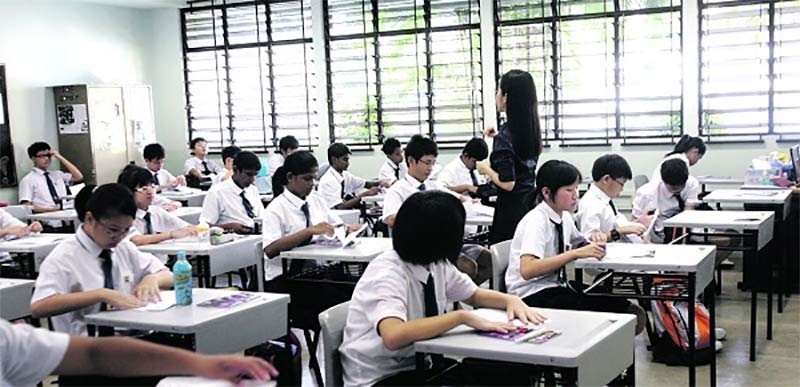Can You Afford To Send Your Child To Study In Singapore?

Singapore has long been a popular destination for top-quality education. A recent survey on global school rankings by the Organisation for Economic Co-operation and Development (OECD) further solidified this reputation when it found that Singapore has the best schools in the world.
This is followed by Hong Kong and South Korea. Meanwhile, Malaysia sits on the 52nd spot of the 76 countries surveyed.
As is, many Malaysian parents are already sending their children on a daily commute across the Causeway to study in Singapore public schools.
Just how much would it cost to send your children to study in the thriving, cosmopolitan and business-orientated island? We take a look at some considerations:
1) Tuition fees – Public or private schools?
The fees at public schools in Singapore are standardised by the Ministry of Education, where foreign students are charged slightly higher fees than local Singaporean students.
Here’s how much it would cost a Malaysian to study in a Singaporean public school every month. The rate applies for all internationals students from ASEAN countries:
| Level of Education | Monthly School Fee | Monthly Misc. Fee | Total |
|---|---|---|---|
| Primary | S$350 (RM1,076.23) | S$13 (RM39.97) | S$363 (RM1,116.20) |
| Secondary | S$450 (RM1,383.44) | S$20 (RM61.49) | S$470 (RM1,444.93) |
| Junior College | S$700 (RM2,152.06) | S$27 (RM83.01) | S$727 (RM2,235.07) |
You may find a more detailed fees structure here.
The 2013 hike in education fees for foreign students at all levels – from primary all the way through to pre-university has put many Malaysian parents under financial strain, especially after the 3.07x (at the time of writing) conversion rate.
However, it is still more affordable than what many private schools in Malaysia are charging, which could be anywhere from RM10,000 to RM100,000 per annum.
The downside is, availability at these public schools is often limited. The best schools have long waiting lists and preference is given to citizens.
Due to this, foreigners may have to opt for private or international schools in Singapore, which could cost around S$20,000 (RM61,509) to S$30,000 (RM92,263) per annum. A boarding school would cost about twice of that.
Parents should note that some schools will charge up to an additional S$10,000 (RM30,754) in various admission and registration fees, as well as for uniforms, canteen lunches, extra-curricular activities and school outings.
2) Transportation

There was a massive increment in school bus operations last year (at about 30%) following the hike in toll rates at both the checkpoints in Malaysia and the island republic.
Today, parents who intend to send their children to study in Singapore need to be prepared to fork out at least RM400 per month for bus services to make the daily trek across the Causeway.
In 2013, Century Bus, the biggest Singapore-Malaysia school bus operator, estimates that they ferry at least 1,000 Malaysian students daily.
Despite the recent hike in school fees and transport costs, the number of Malaysian students studying in Singapore appears to be increasing. Many Malaysian parents admitted that the increase in fees was a strain on their wallets, but were willing to put up with it for the benefits of an English-medium education.
3) Living expenses

Parents who decide to send their children to live and study in the island republic will need to take note of the following living expenses:
Accommodation:
Cost of accommodation in Singapore depends on factors like the property’s proximity to the city, age of the property, and its accessibility to facilities like public transport.
According to Numbeo, rent for a one-bedroom apartment in the city centre could come up to an average of S$3,200 (RM9,841) in a month, while a one-bedroom apartment outside the city centre could amount to an average of S$2,150 (RM6,612).
Meanwhile, monthly rent for a three-bedroom apartment in the city centre could cost about S$5,700 (RM17,530) while one outside the city centre could cost an average of S$3,500 (RM10,764) in a month.
You will also need to factor in costs like gas, water and electricity, which could range from S$200 (RM616) to S$600 (RM1,845) a month.
Food:
Food is relatively cheap in Singapore. On average, lunch at a hawker centre can be as low as S$4, whereas options at a food court would go for about S$5 (RM15.40) – S$6 (RM18.45). A trip to McDonalds will cost you about S$7 (RM21.53), while a drink at Starbucks costs between S$6 (RM18.45) and S$7 (RM21.53).
Meanwhile, eating at a restaurant will set you back roughly by S$20 (RM61.50) to S$40 (RM123) per meal.
Transport:
Singapore has one of the best and most affordable public transport systems in the world. A one-way bus or Mass Rapid Transit (MRT) fare is about S$1.80 (RM5.54). A monthly MRT pass costs S$100 (RM307.54).
If you travel regularly within Singapore, using MRT or bus, a monthly transportation budget of roughly S$150 (RM461.32) should be enough to cover most of your travel expenses.
Miscellaneous:
Mobile phone subscriptions in Singapore cost between S$35 (RM107.64) to S$100 (RM307.54) per month. Broadband Internet connection at home will cost around S$50 (RM153.77) per month.
Movie tickets go for about S$10 (RM30.75) and a copy of local newspaper will cost about S$1.00 (RM3.07).
Of course, the above is just a rough guide and any unexpected fee increases and exchange rate fluctuations could throw these cost estimations out the window. So be sure to factor in any possible cost increments and prepare for any additional surcharges before you take the leap!
Is it worth sending your child to study in Singapore? Let us know what you think in the comments section below.
This article has been updated on Sept 10, 2015 to reflect the current conversion rate of S$1 = RM3.07.










